|
Monday, August 31, 2009
Progress Notes
One of the objectives of this page of our website is to maintain a theme pertaining in some way to Miller County history no matter what the subject might be. Several good resources about our county’s history are available beginning with the Goodspeed’s Miller County History publication of 1889. The book The History of Miller County by Gerard Schultz published in 1933 also is very good. The most complete book of Miller County history was written by Clyde Lee Jenkins in two volumes. He never published his two volumes through a commercial outlet but had them produced privately. None is available now for sale except by individual owners. Our own board member Peggy Hake may have written as much as anyone about Miller County but she did this for the most part as individual articles published in the local newspapers or kept on file in her own personal extensive library of Miller County history (photo 01).
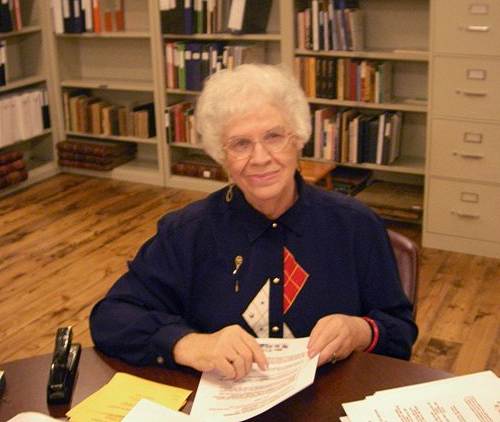
01 Peggy Hake One interesting variation of presenting Miller County history was written by Peggy for the Miller County Autogram Sentinel several years ago emphasizing important milestones or dates at which time important events in our history occurred. So this week’s narrative will present that article:
Miller County History
Peggy Hake
Miller County Autogram Sentinel/Eldon Advertiser
August 13, 1987
Between July 31-August 6, 1806, Zebulon M. Pike, as part of the Lewis and Clark expedition, lead a group of explorers which passed through present day Miller County. They traveled the Osage River on their way west, eventually reaching Colorado (photos 02 and 03).

02 Zebulon Pike
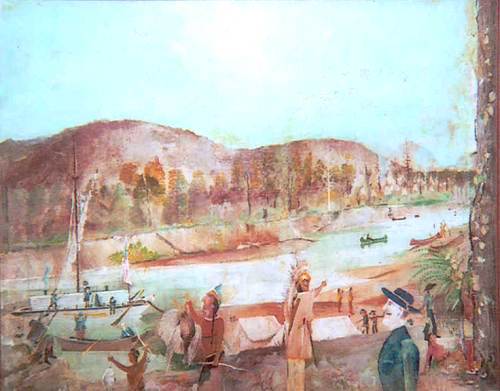
03 Pikes Landing at Tuscumbia by painter John Wright Note: you can read all about this famous expedition by Pike on our own website as written by Peggy.
July 20, 1826, the first land entry was made in what is now Miller County by William Miller (photo 04). It was in section 23, Township 42, Range 14 near Spring Garden.
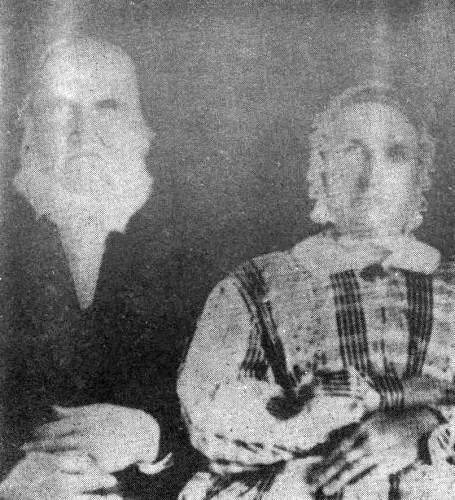
04 William and Sarah Miller Note: here is the plat map of T42N R14W as recorded in 1905 and a closeup of Section 23 (photos 05 and 06):
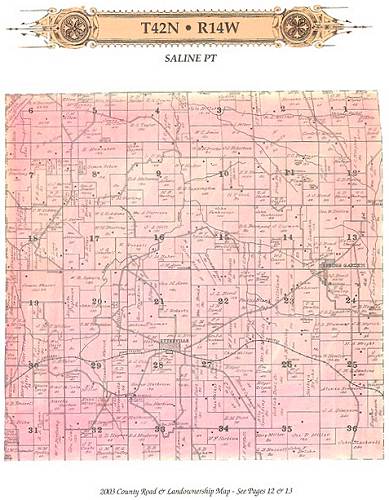
05 T42N R14W - 1905
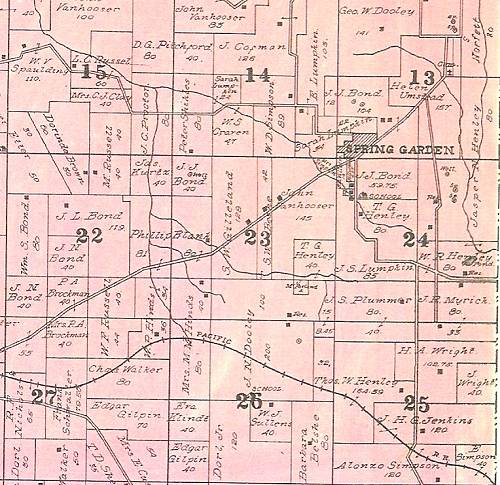
06 T42N R14W - 1905 - Cropped
Click image for larger viewIn 1834, the first water mill was built in Miller County by William Brockman on the Saline creek and a few years later, William Williams built the second mill in the county. The first steam mill was built in 1853 by John Humes near Mt. Pleasant.
December 21, 1837, the first post office in the county was established at Tuscumbia with James Pryor Harrison as the first postmaster. Mail was delivered on horseback once a week from Waynesville to Jefferson City via Tuscumbia.
On February 6, 1837, the governor approved an act to organize the county of Miller and to define the southern boundary of Cole. The county was named for John Miller, Governor of Missouri, 1826-28. The legislature directed "until the permanent seat of justice shall be established, the several courts for said county shall be held at the house of William Miller. William Miller, referenced above as having the first Miller County land entry at Spring Garden, had moved south to a farm on the Osage River near Tuscumbia. It was at this location that the official temporary court for Miller County was established by Governor John Miller. This temporary seat was William Miller's log house on what was later known as the Charles P. Tellman farm (photos 06a and 06b).
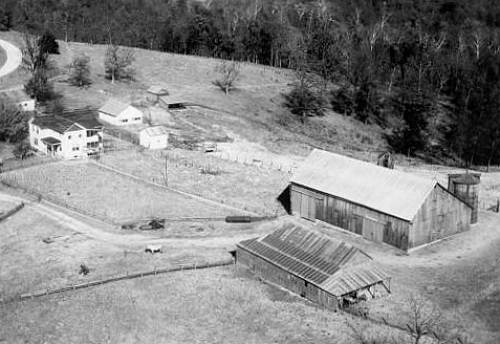
06a Miller Tellman Farm - 1940
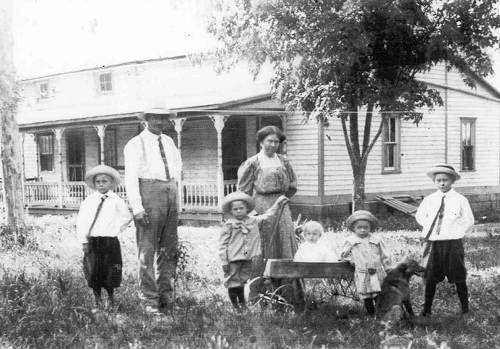
06b Tellman Home built on to William Miller Log Cabin You can read more about the Tellman farm on a previous Progress Notes.
On February 4, 1840, the county court divided Miller County into 14 school districts.
On February 26, 1837, the first marriage in the county was performed between Sims Brockman and Rachel Gartin by Andrew Kingery, a Minister of the Gospel.
November 6, 1837, the county court issued a merchants license to William H. Pulliam, who had a frontier general store near the present site of Iberia.
In 1851, Miller County had four post office sites…Iberia, Pleasant Mount, Rocky Mount and Tuscumbia.
October 3, 1860, the original plot of the town of Iberia was filed for record by Henry M. Dickerson with only two streets laid out…Main Street and St. Louis Street.
Note: here is the earliest plat map of Iberia I could find (photo 07):
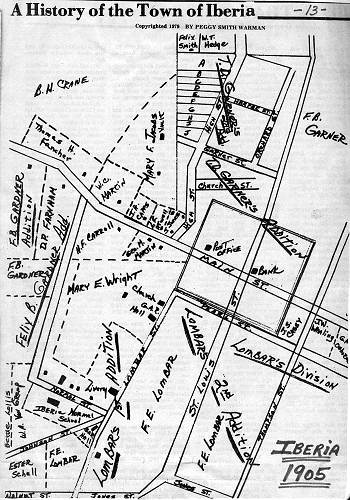
07 Iberia Plat Map - 1905
Click image for larger viewIn 1870, the first Catholic Church in the county was built at Old St. Elizabeth on the east bank of the Osage River. The town and church was founded by an Irishman named Owen Riggs.
You can read more about Owen Riggs, one of the most important early Miller County settlers at these websites:
http://www.millercountymuseum.org/071105.html
http://www.millercountymuseum.org/catholic.html
March 15, 1882 the original plot of the town of Eldon was filed by George R. Weeks (photo 08).
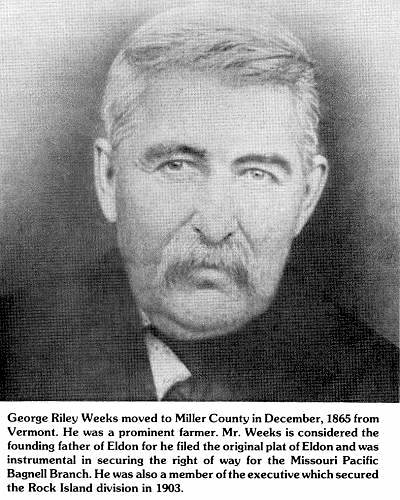
08 George Weeks Note: Here is a photo of the ox yoke George used to come to Eldon. It is on display in our museum (photo 08a):
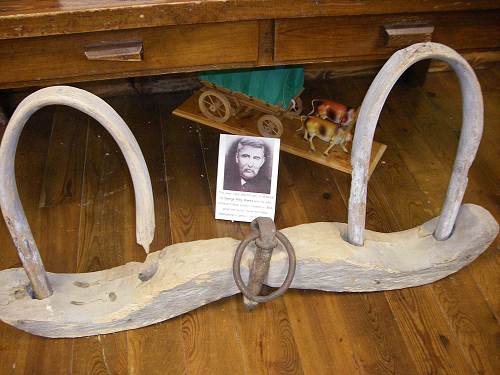
08a Yoke for oxen used by George Weeks The town became a reality after the railroad bypassed Aurora Springs and was built a few miles further north.
In 1883, the first railroad tax was paid to the county by the Jefferson City, Lebanon, and Southwestern railroad.
1870, the first newspaper in the county was established at Tuscumbia called The Osage Valley Sentinel. Other early newspapers included: The Tuscumbia Republican, The Gospel Messenger, The Miller County Vindicator, The Eye Opener, Osage Valley Record, The Western Preacher, The Miller County Vidette, The Helmet, The Osage Valley Banner, The Iberia Intelligencer, The Iberia Impetus, the Iberia Advocate, The Iberia Headlight and others…
Note: our website has an article about some of the old newspapers in Miller County.
October 31, 1895, the first suspension bridge to span the Osage was dedicated at Tuscumbia (photo 09).
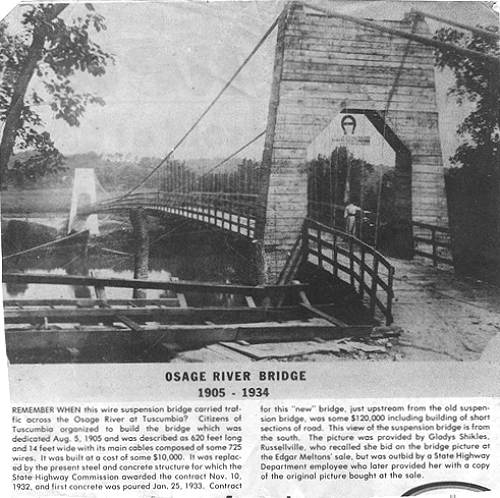
09 Osage River Suspension Bridge
Click image for larger viewIn 1840, the first paupers were farmed out by the county court.
In 1855, the first river improvement was voted on.
In 1875, the first County Farm Superintendent, J.G. Hoff, was appointed.
Note: you can read more about the “poor farm” which was started later in the 1800’s on a previous Progress Notes.
In July, 1837, the County was road districted and the first ferry permit was granted to Cornelius P. Davidson at Tuscumbia (photo 10).
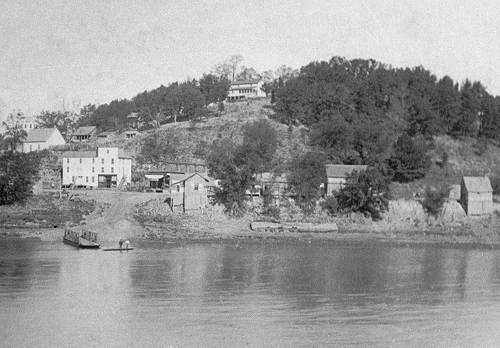
10 Ferry Landing at Tuscumbia At the June, 1837 county court, the first merchants licenses were issued to P. Dickson/Dixon, Zachariah Price, and Andrew Burris.
In 1839, the first courthouse was built, a 35` X 20` log building (photo 11).
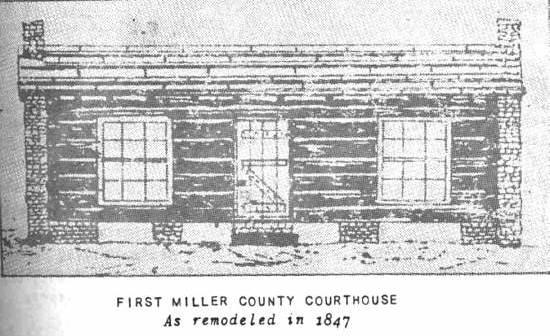
11 First Miller County Courthouse The first jail, a 19` X 19` log house, was built about the same time, a short distance north of the log courthouse (photo 12).
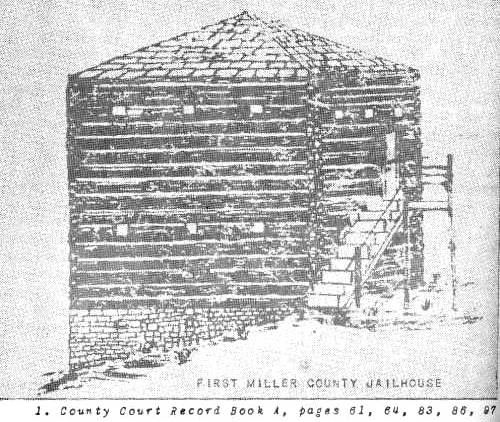
12 First Miller County Jailhouse The second courthouse was built in 1858, a 40` X 56` 2 story brick building with a gabled roof. It had a courtroom below with offices in front and above. A low bid of $6,000 was let to Robert McKim for the construction (photo 13).
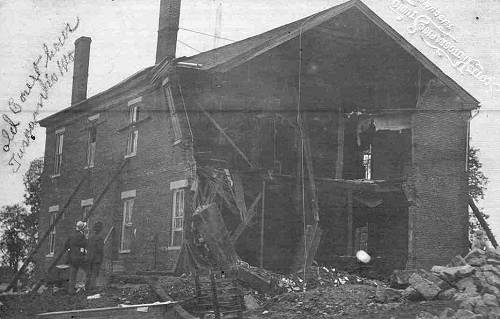
13 Second Courthouse being Remodeled - 1909 In 1865, a stone jail was built in the courtyard. In 1879, one cell of it was leased to the town of Tuscumbia for a calaboose.
In 1840, the financial statement of Miller County showed $2,312.76 expended. By 1880, the figures were $9,403.92 received and $8,701.01 expended. The financial condition of the county improved well over the four decades between 1840-1880.
By 1889, the county had never issued any bonds. Funds were taken from the Road and Canal Fund and the Internal Improvement Fund.
The oldest road in Miller County was the Springfield Jefferson City road, running generally north and south passing through Tuscumbia. Another old road was the Little Piney River-Versailles Road taking a northwesterly direction through Iberia at Tuscumbia.
In 1888, the county had 18 ¾ miles of railroad tracks within the county boundaries (photo 14).
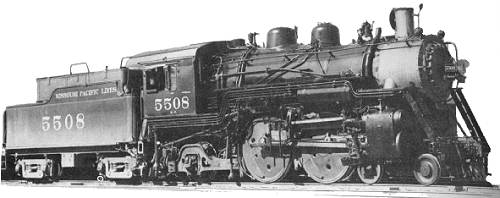
14 Missouri Pacific Engine The property was assessed at $71,285.09 for the railroad and $1,500.00 for the telegraph system.
Note: you can read more about the Miller County railroads on a previous Progress Notes.
During the 1870’s, horse racing, embezzlements, abortion , burglary, and a few new cases come up and by the 1880’s almost every variety of cases, known to ordinary circuit courts, appeared in Miller County.
Some of the “firsts” of the county included:
First divorce case in 1838: Lucinda Anderson vs. James Anderson
First Mortgage foreclosure 1839…against S.L. Cole.
First naturalization of an emigrant 1840…Emmanuel Godlove of Bavaria.
First liquor law violation 1845…against Calvin and Owen Riggs.
First case for “killing hogs” 1848…against John and Noah Hudson.
First “Betting on elections” 1853…against William N. Harrison.
First Miller County sheriff: William N. Harrison.
First woman elected to county office: Cynthia Hawkins Spearman, a well known schoolteacher of the 19th century in the county. She served as Superintendent of Public Schools of Miller County during the years 1895 and 1896 (photo 15).
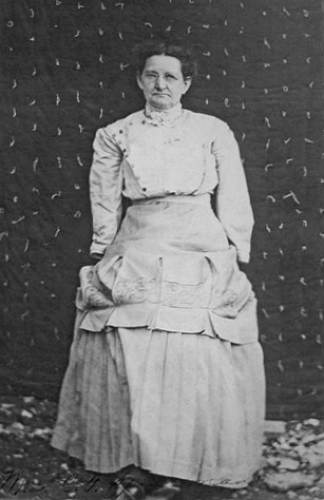
15 Cynthia Hawkins Spearman Olean, in the extreme northern section of the county, has been known by four different names…Proctor, Cove, Chester, and finally Olean. Also Miller County’s first bank was established at Olean on August 20, 1889, the Miller county Exchange Bank (photo 16).
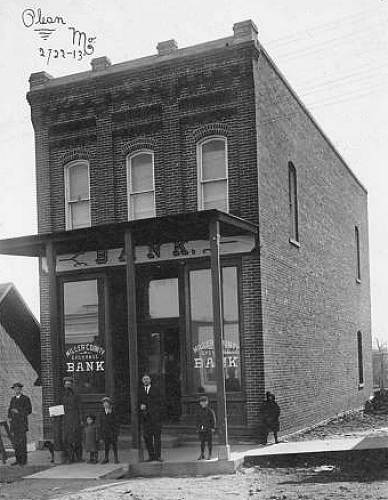
16 Olean Bank Aurora Springs was the county’s largest town during the 1880’s and 1890’s, due to the discovery of mineral springs in the region. In 1881, approximately 20 new buildings sprang up in the “boom town.” When the railroad bypassed the town, it began to decline and almost disappeared. In 1890, the town had a population of 421 persons.
Note: you can read more about Aurora Springs on our website.
According to the Miller County census of 1860, there were three Baptist churches, two Christian (Campbellites), two Methodist, and one union church within the county. By 1890, there were 59 church organizations within the county.
In 1878, Miller County employed 56 schoolteachers with a monthly salary of $22.50 each. There were 65 schoolhouses, but only 56 were in use. Fifty five of the schools were for the white children and one for the black children.
Early private schools in the county included the Spring Garden Academy in 1868 (photo 17); Spring Garden Seminary 1879; Miller County Academy at Aurora Springs in 1884; Eldon Academy in the 1880’s; and Iberia Academy which began in 1890 (photo 18).
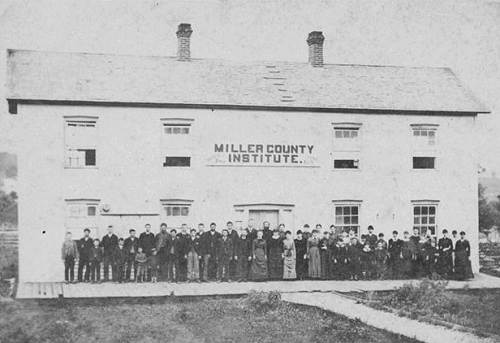
17 Miller County Institute
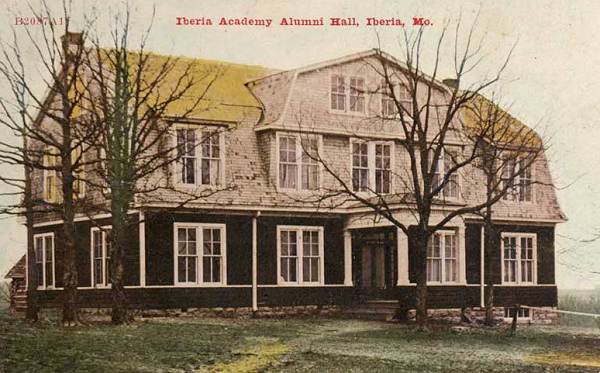
18 Iberia Academy - 1909 Miller County contains approximately 590 square miles of land. The length of the county from north to south at one point is about 28 miles. The population of the county in 1840 (after formation) was 2,282. The population in 1930 had increased to 16,728; in the census 1980, the population has grown to almost 19,000. As of the census of 2000, there were 23,564 people
Norah Harbour Parrish, a Judge of Miller county’s Probate Court in the 1930’s, was the first woman to be elected as a probate judge in the state of Missouri.
On June 5, 1913, the town board of Iberia (incorporated as a town in 1875) ordered five electric lights to be installed on the streets (photo 19).
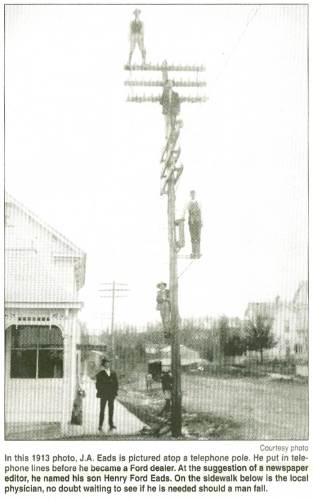
19 J.A. Eads (at top of pole) putting in Telephone Lines In 1918, the great influenza plague, which took many lives, ran rampant in the county. On October 5, 1918, John Ferguson (photo 20), Chairman of Iberia’s Town Board, ordered through a proclamation….”all schools, churches, and public places be closed during the prevalence of this influenza epidemic.”
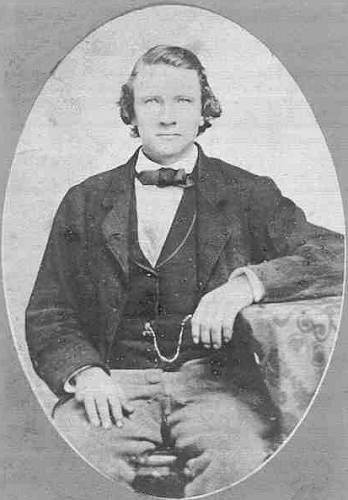
20 John Ferguson On August 17, 1924, William Jennings Bryan (photo 21), famed attorney, made a short address in Eldon. He spoke to the crowd from the rear car of the Rock Island Colorado Flyer.
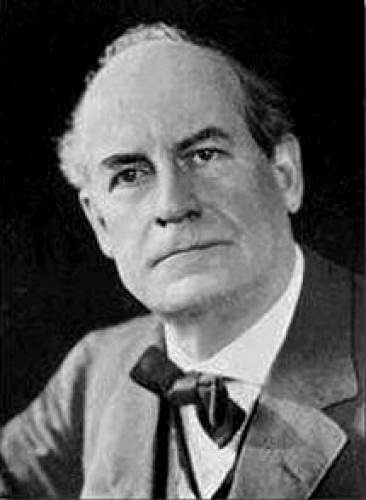
21 William Jennings Bryan On March 27, 1929, the County Court awarded the contract to construct a new jail to W.W. Hocker of Sedalia. The bid was $7,249.36. Final cost was almost $10,000 (photo 22).
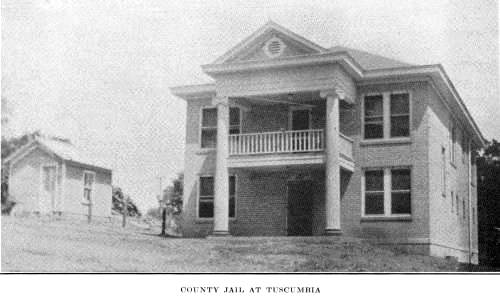
22 Third Miller County Jail August 6, 1929, construction began on a dam across the Osage River (photo 23).

23 Bagnell Dam The new county home (also called an almshouse) was opened on August 4, 1931. It was located southeast of Tuscumbia on Highway 17. It contained 198 acres of farmland when first purchased (photo 24).
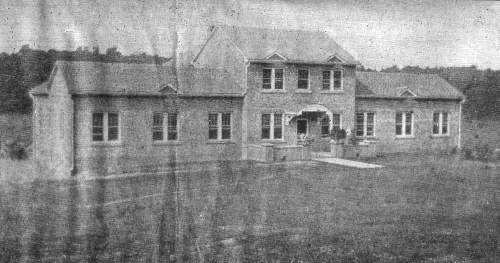
24 Miller County Nursing Home Miller County’s first historical Society was formed on November 18, 1931. the meeting was held at Iberia’s Academy and Junior College. Officers elected were: Gerald Schultz, President (photo 25); and Clifford H. Clark, Secretary/Treasurer.
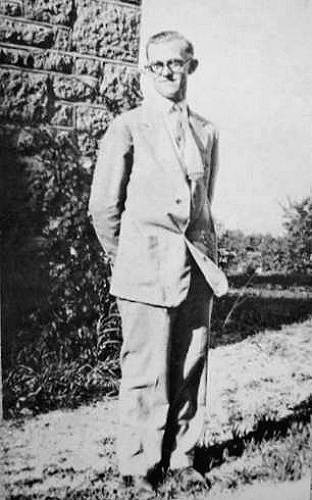
25 Gerard Schultz October 1, 1932, a new post office was opened called Lake Ozark. Frank Andrews was the first postmaster of the new Miller County post office (photo 26).
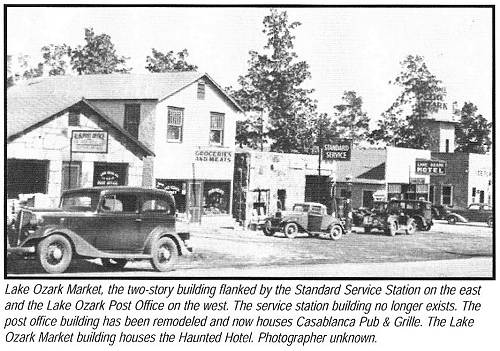
26 Lake Ozark Post Office
Click image for larger viewOn May 2, 1933, construction began on the new steel structural bridge across the Osage River at Tuscumbia. Final cost of the construction was $145,000 (photo 27).
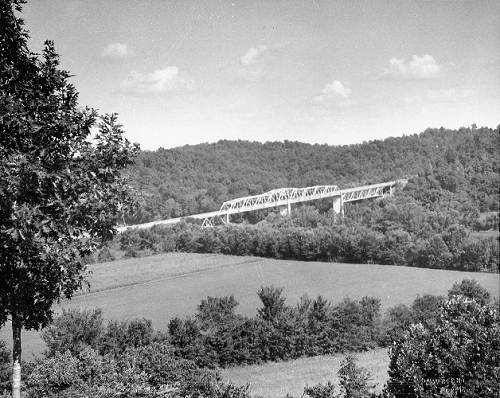
27 New Bridge at Tuscumbia - 1933 Miller County once had a township named Reed. It was formed in 1837 from part of Equality Township but was soon abolished.
The remains of the first courthouse, built in 1839 on Lot 12 in Block 23 in Tuscumbia and not on Courthouse Square, were still in existence in 1889 when Goodspeed’s History of Miller County was published. The remains of the building were “in the street south of Honorable T.B. Robinson’s laws office.”
In 1889, Eldon had three hotels built in the new city which sprang up around the railroad tracks…The Cottage, operated by Mrs. Hattie James (photo 28); The Goss House by J. Goss; and The Eldon Hotel by John Brickey.
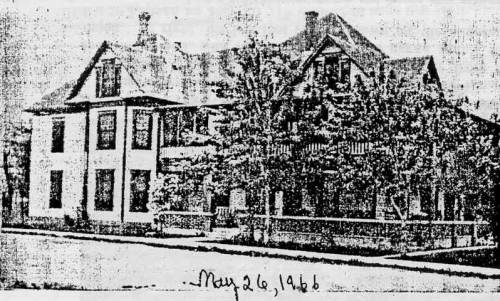
28 James Hotel - 1966 By 1889, Eldon had only one newspaper, The Eldon News, published by L.F. Hart as a Republican paper. It only existed for a few months in 1886.
In the 1860’s and 70’s, Jesse and Frank James, the well known Missouri outlaws, frequented the backwoods trails of Miller County. They visited their cousin, Mildred James Wall and her husband Jim Wall (photos 29 and 29a), at their trading post in southern Richwoods Township called Faith.
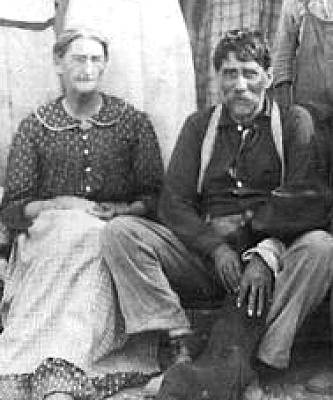
29 Mildred and James Wall
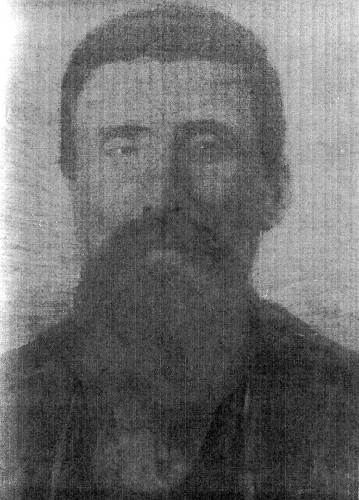
29a Black James Wall - Died 1928 The first name given to The Lake of the Ozarks was Lake Benton by an act of the General Assembly of Missouri. The builders called it Lake of the Ozarks and the popular name remained.
The Osage Indians, who dwelt in the land of Miller County long before it became a county, were the tallest race of men in North America. Few were under 6 feet and some reached 7 feet in height (photo 30).
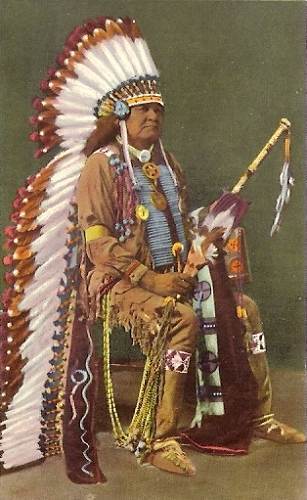
30 Osage Indian Chief Miller County’s growth halted during the Civil War era, but lead mining from the 1870’s into the early 1900’s increased the population. In May of 1875, the lead furnace at Gageville was running three shifts every 24 hours and was turning out more lead than ever before (photo 31).

31 Lead Ore from Gageville Mine Note: you can read more about Gageville and the mine at this previous Progress Notes.
Miller County had a race track in 1876. It was located ten miles south of Tuscumbia at a place called Arnold’s Mill. In a race held there in early September, 1876, a Miller County horse named Lady Spot out ran a Phelps County horse named Black Ram and came in for first place.
Three weeks ago I wrote about the Eads family of Iberia.
In that narrative I mentioned that Alfro Eads had come to Iberia from Maries County to be a driver for Dr. William von Gremp. I speculated that Alf knew Dr. von Gremp because Alf’s father, Joe Eads, was married to a von Gremp but I didn’t know then the exact relationship. Investigating further, I contacted Mary (Messersmith) von Gremp, daughter in law of Dr. von Gremp, who not only sent me a genealogical history of the von Gremp family written by Peggy Hake but also a couple of photos of Dr. von Gremp. The answer to the question I had was contained in Peggy’s narrative. As it turns out, Joe Eads was married to the sister of Dr. von Gremp, so Alf was his nephew.
Here are the two photos Mary sent (photos 32 and 33):
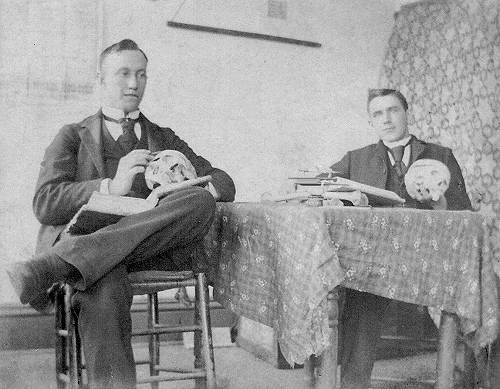
32 William A. von Gremp (Left) in Medical School
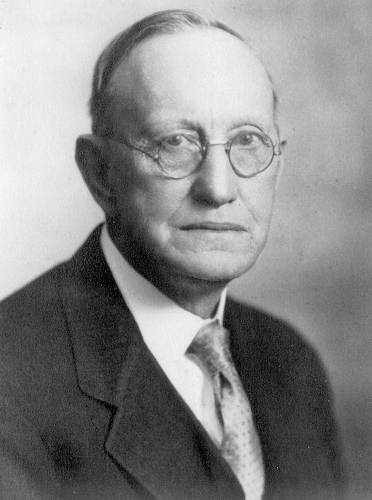
33 William A. von Gremp M.D. And here is Peggy’s narrative:
Eldon Advertiser, Eldon, Missouri, January 23, 1997
Window to the Past
Peggy Smith Hake
Louis Gremp von Freudenstein was born July 22, 1832 in Germany. His grandfather, whose name I do not know, made a will leaving his estate as an endowment fund, the interest only of which was to be used for the education of the male members of the family, each drawing money from six and half years of age to 26 years. The females were not as important in those days! Louis took advantage of his grandfather’s generosity, as did his sons in later years. He had three sons who became doctors and one who was an educator.
When Louis was about 25 years old (circa 1857) he came to America from his German homeland and settled in Maries County, Missouri. Later he received his citizenship in that county. On August 29, 1859, he married Eliza Copeland, who was living in Maries County with her family. She was born August 30, 1832 back in East Tennessee. Eliza was a daughter of Solomon and Melinda Copeland, early pioneers of Maries County.
Louis Gremp von Freudenstein and his wife, Eliza, traveled around awhile after their marriage. They moved to Hickory County, Missouri for awhile and then moved to Boone County, Missouri. Around 1886, they moved back to Maries County and bought a farm about four miles east of present day Brinktown. I would presume some of their children were born in all three Missouri counties since they moved quite often over the ensuing years. They were parents of eight children:
1. Solomon Alphro, 1859-1900 m. Missouri Annette Felker 1884;
2. Charles M., 1861-1881;
3. Henry Jackson, 1863-1930 m. Hattie Felker;
4. Fannie I., 1865-1900 m. Joseph Eads;
5. Christian C., 1867-1899 m. Harriett M. ?;
6. William A., 1869-1933 m. 1-Emeline ?; 2-Anna M. Johnston 1900;
7. Melinda C., 1872 m. ?
8. Mary E., 1874 m. ?
Louis Gremp von Freudenstein evidently changed his name after coming to Missouri. The family became more familiarly known as “von Gremp” and sometimes just “Gremp.” Louis died at age 71 in September 1903 and was buried at the Vienna City Cemetery. Eliza (Copeland) von Gremp died in 1905 and was buried beside Louis at Vienna.
Now, to the family records for some of the children of Louis and Eliza:
Dr. Solomon Alphro von Gremp, oldest son of Louis and Eliza, was born in Maries County, Missouri, October 5, 1859. He received his education at the Christian Institute in Hickory County, Missouri and in 1879 entered the Medical Department of the State University at Columbia where he graduated in 1882. In 1883, he set up his medical practice in Vienna where he practiced until his death in 1900.
On July 2, 1884, Solomon married Missouri Annette (Nettie) Felker, a daughter of John Felker (1830-1889) a native of Germany and Amanda M. Anderson (1832-1878), a native of DeSoto County, Mississippi. Dr. Solomon and Nettie had one daughter, Lena Eliza, born April 19, 1885. I do not know if there were more children. Dr. Solomon von Gremp died at age 41 in 1900. His wife, Nettie (Felker), lived until 1913. They are also buried at Vienna City Cemetery.
Dr. Henry Jackson von Gremp was the third child of Louis Gremp von Freudenstein and Eliza Copeland. He was born March 31, 1863 and became a doctor, also. He married another member of the Felker family, Hattie Felker. I think her name was Harriett Felker (called Hattie), another daughter of John and Amanda and a sister to Nettie Felker von Gremp.
When Dr. Solomon von Gremp died, it appears that Dr. Henry von Gremp may have taken over the duties as Vienna’s physician.
However, in 1904, Dr. Henry was inspector on the grounds at the World’s Fair in St. Louis in Forest Park. This little news item was found in the old newspaper “The Home Advisor” of Vienna, printed in May 1904. Later that year (December 1904), Dr. Henry J. von Gremp was appointed as “Physician of the County Board of Health” in Maries County. In this position he was paid for services to the poor and indigent at the poor farm, the paupers and inmates of the county jail.
In December 1907, Dr. Henry J. von Gremp left Vienna and set up his medical practice in Dixon where he lived for many years. He died in August 1930 at the age of 67 years with death being caused by a tragic accident in which according to his death certificate he was hit by a train (photo 33a). His wife Hattie (Felker) died several years earlier in January 1914.
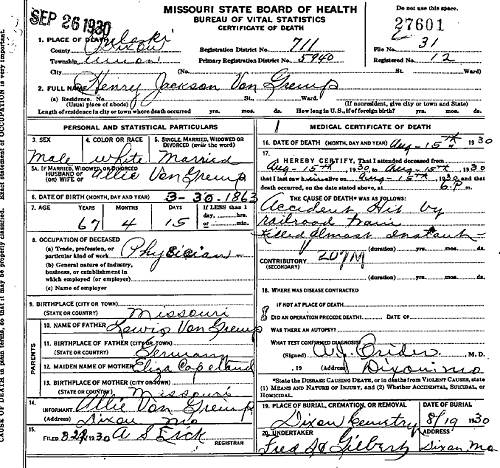
33a Death Certificate - Henry Jackson von Gremp
Click image to view full size PDF documentDr. William A. von Gremp, the sixth child of Louis Gremp von Freudenstein and Eliza Copeland, was born in June 1869. In his early adulthood William was a teacher but later became a doctor also, following in the footsteps of his older brothers.
William first married Emeline (last name unknown) and they became parents of two sons: Walter von Gremp born in December 1894 and Earl von Gremp born in October 1899. When Earl was only a few days old both he and his mother, Emeline, died and were buried at Eads Cemetery in Maries County. By 1900, William A. von Gremp and his small son, Walter, had moved to Miller County and were living in the town of Iberia. That same year (1900) on June 11, William von Gremp married Anna M. Johnston a daughter of George and Laura J. (Irwin) Johnston. Anna was born in 1881 and was about 12 years younger than William.
Dr. William and Annie became parents of several children including: Bluford, Vivian, Zella and James. They also had at least two other children who died in infancy. Most of the children of Dr. William von Gremp attended Iberia Academy, including his first son, Walter. Dr. William and Annie (Johnston) von Gremp were active members of the Iberia Congregational Church, which was also the sponsor and benefactor of Iberia Academy. She joined the membership roll in 1894 and Dr. William joined in 1899 when he moved to Iberia from Maries County.
Dr. William von Gremp died in 1933 at age 64. Annie Johnston von Gremp lived for 37 years as his widow and died in 1970 at age 89. Both are buried at Iberia City Cemetery.
Thanks Peggy.
Here is the original obituary of Dr. von Gremp:
Iberia Sentinel, July 1933
The Death Angel has again invaded another Iberia home and taken from our midst, Dr. William A. von Gremp, a capable and successful physician here for many years. Death occurred at about ten o'clock last Saturday evening, July 15th.
Dr. von Gremp had enjoyed normal health up until a few weeks ago when he became afflicted with a throat trouble which grew alarming. On June 11th he went to Chicago to consult a specialist in regard to his condition and a few days later submitted to an operation. He seemed to be getting along satisfactorily from the operation and was able to be brought home July 7th. After returning home, although confined to his bed, he apparently seemed to improve until a short time before his death, when he complained of pains about his chest which soon gave the family warning of the impending danger. Dr. Duncan, local physician, and Dr. Mallett of Crocker were called and before the latter arrived, Dr. von Gremp had passed away. The immediate cause of his death was pronounced a blood clot in the artery leading to the heart.
Dr. von Gremp was born in Maries County, Missouri, June 22, 1869. His parents were of German ancestry, evidently belonging to the nobility. He received his early education in the public schools of Weaubleu and Columbia, Missouri. He continued his education at the University of Missouri and in 1893 completed his medical course at the St. Louis College of Physicians and Surgeons which conferred upon him the degree of M.D. He first located for practice at Dixon, Mo. About 1898 he entered upon practice at Iberia where he has since remained with the exception of a few years. He was first married to Miss Emily Pickering who died at an early age. To this union was born his son, Walter, who is a captain in the United States Army and is at present stationed in northern Michigan.
On June 13, 1900, at Iberia, Dr. von Gremp was united in marriage to Miss Annie Johnston, daughter of Mr. and Mrs. George Johnston, one of the pioneer families of Iberia. This union is survived by two sons, Blufford and Ellis, and two daughters, Zella and Vivian. The deceased is also survived by one sister, Mrs. Louis Conley of Columbia, Mo. His brother, Henry von Gremp, also a physician, died at his home in Dixon a few years ago.
Dr. von Gremp enjoyed a wide practice which included southern Miller County and extended into the neighboring counties of Maries and Pulaski. He not only possessed a broad scientific knowledge, but also a humanitarian spirit which found expression in cheer, helpfulness and sympathy.
The deceased was a member of the Congregational Church at Iberia. Fraternally he was a Mason, member of the local order.
One interesting occurrence in the practice of Dr. von Gremp was made known to me by my website manager David Statler. He discovered that Dr. von Gremp was the physician who signed the death certificates (photos 33b and 33c) of both Black Jim Wall and his wife Mildred (see photos 29 and 29a above).
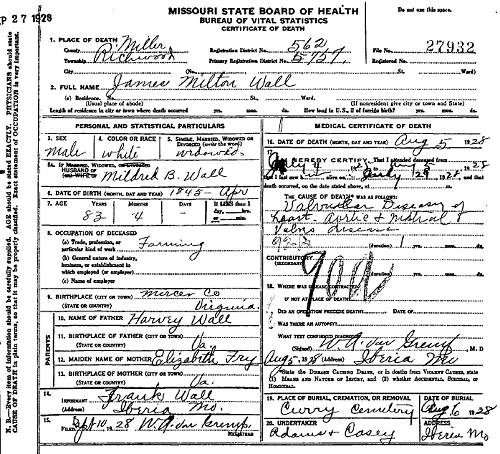
33b Death Certificate - James Wall
Click image to view full size PDF document
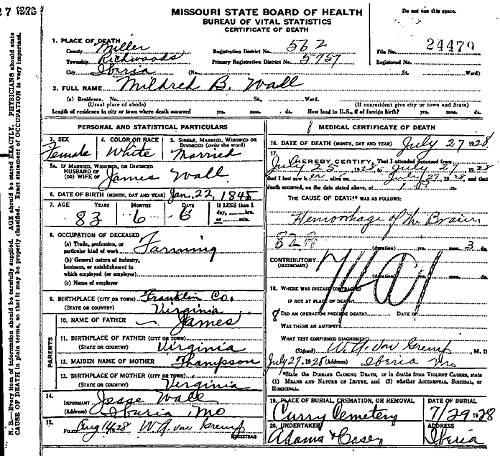
33c Death Certificate - Mildred Wall
Click image to view full size PDF documentYou really must read the story of Black Jim and his wife Mildred on our website.
Mildred was a cousin of Jesse and Frank James, the infamous Missouri outlaws. The brothers (photo 33d) visited their cousin Mildred often, which spawned many tales, both true as well as questionable.
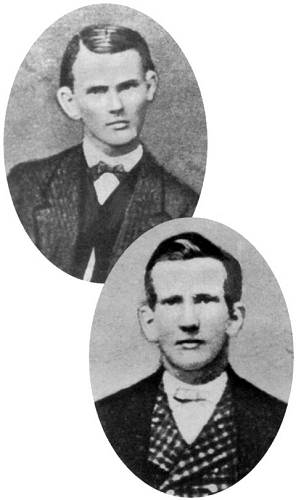
33d Jesse and Frank James
Last week I had the pleasure of hosting Helen Phillips of Eldon and her great grandson, Trevor Hoehn of Lee’s Summit, at the museum. Meeting us there were John and Nancy Vanosdoll, long time friends of Helen (photo 34).
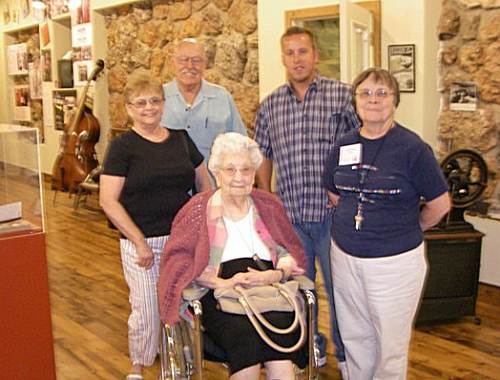
34 Helen Phillips, Nancy and John Vanosdoll, Trevor Hoehn and Nancy Thompson I had written a couple of weeks ago about John’s grandfather, Clark Vanosdoll, and had depended to a significant degree on historical materials supplied me by John. Helen had worked six years for Clark before she married Louis Phillips and entered the mortuary profession so she was able to offer some very interesting information about Clark Vanosdoll for that narrative. If you missed it you can read about the Vanosdoll family of Eldon at this previous Progress Notes.
Helen was born in Tuscumbia being the daughter of Fred Fendorf, who worked at the Bank of Tuscumbia. Unfortunately, Fred passed away at an early age after which Helen and her mother moved to Eldon when she was only a third grader. Because Helen had several Fendorf relatives in Tuscumbia she visited the community often through the years and because of her extraordinary memory can still identify where various homes or businesses no longer present were located. So before we toured the museum we took a trip through Tuscumbia so Helen could identify for Trevor some of the important landmarks, especially those having to do with the Fendorfs’. One very important structure still present in Tuscumbia was the home where Helen’s father, Fred, was raised. Trevor was delighted to have the opportunity to photograph this family landmark. Here is a photo taken of the home in the 1940’s when Helen’s Aunt Ella Fendorf Swanson lived there (photo 35).
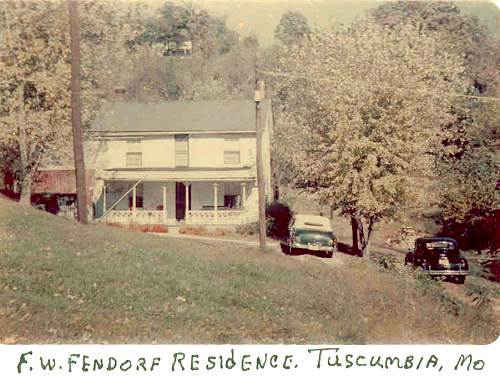
35 Fendorf Home in Tuscumbia Helen has donated many historical items to our museum. One of the latest was a desk made by her father, Fred, before Helen was born. Helen hadn’t been to the museum since the desk was displayed so I took her to that location first (photo 36).
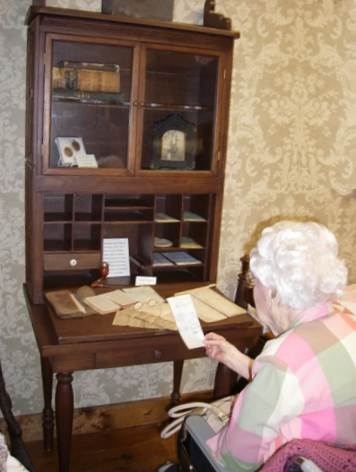
36 Helen at Fred Fendorf Desk Everytime I visit with Helen I learn something I hadn’t known before about Miller County history. She is such an invaluable resource!
You can read more about Helen’s life story in two previous Progress Notes narratives at these URL sites:
http://www.millercountymuseum.org/080818.html
http://www.millercountymuseum.org/070826.html
That’s all for this week.
 Joe Pryor
|



